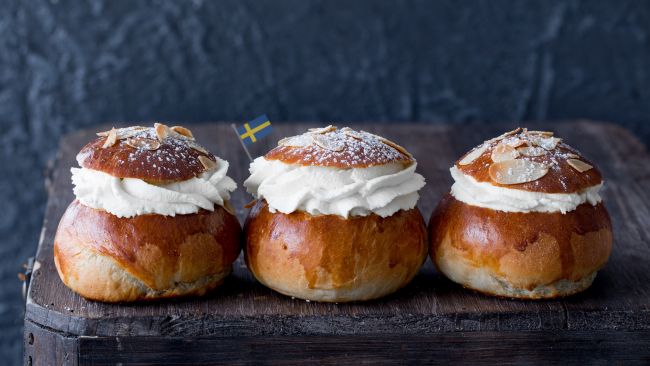A Guide to the Delicious Swedish Semla Bun
The Swedish semla bun is one of the most iconic pastries in Sweden. This delicious bun is traditionally enjoyed during the Lenten season and on Shrove Tuesday. It’s the perfect indulgence during the cold winter months in Sweden.
The semla is a sweet, fluffy bun filled with almond paste and whipped cream. In this article, we’ll explore the history of the semla, when to eat them, where to find them, and how to eat them like a local. You will also find a Swedish semla recipe if you want to bake a bun.
When Do You Eat Swedish Semla?
 The semla is traditionally eaten during the Lenten season and on Fat Tuesday – the official semla day. In Sweden, Fat Tuesday is called “Fettisdagen,” which translates to “Fat Tuesday” in English.
The semla is traditionally eaten during the Lenten season and on Fat Tuesday – the official semla day. In Sweden, Fat Tuesday is called “Fettisdagen,” which translates to “Fat Tuesday” in English.
Fettisdagen is the day before Ash Wednesday, which marks the beginning of the Christian fasting period of Lent. Therefore, this is the perfect time to indulge in a semla before fasting for Lent. Semla Day always happens on a Tuesday and is a big celebration in Sweden.
Today, you’ll even find semla at cafes and bakeries in Sweden from late December until Easter and sometimes even earlier. It is also common that you can buy them at the grocery stores. Many bakeries and cafes offer special deals and discounts on semlas to celebrate the occasion. It’s a great time to try various semlas and find your favorite.
Semla day has many names in Sweden. It is also called:
- Semmeldagen
- Semlans dag
- Fastlagstisdagen
- Den vita tisdagen
History of the Swedish Semla
The Swedish semla has a long history and the pastry dates back to the 16th century, when it was originally a simple wheat bun eaten with warm milk. Over time, the semla evolved into the delicious pastry we know today. Finally, in the 18th century, almond paste and whipped cream were added to the pastry, making it the sweet treat we know and love.
The semla has made its way to neighboring countries in the north. Semla originates from the Latin word semilia, which means flour – a fitting name for this doughy delight. In the southern part of Sweden, the semla is more commonly recognized as “fastlagsbulle”. In Denmark, this pastry is called fastelavnsbolle – named after the Shrovetide holiday – and in Norway, it goes by fastelavensbolle. Our Finnish friends refer to it as laskiaispulla.
How to Eat Semla Like a Local
If you want to savor semla like a true local, follow these steps:
- Start with the lid and use it to scoop up the delicious filling.
- Then, enjoy the rest of the bun
Some people devour the Swedish semla while others use a fork or spoon, depending on their preference. Tourists may feel confused, but fear not – any method is equally delicious. Traditionalists may even order it in a bowl of warm milk, adding an extra layer of comfort to this tasty treat.
The Modern Swedish Semla
As the years have passed, bakeries have taken the traditional semla and added their own twists, all to create the next big sensation. The variety of experimental semla options is remarkable – starting from the semmelwrap, which involves flattening the dough and stuffing it with almond paste and whipped cream, then folding and consuming it like a wrap, to Nutella-filled and fried versions.
Fear not for those with a nut allergy or not fond of almonds! Several bakeries provide vanilla custard instead of almond paste for semlor. Moreover, gluten-free and vegan options are available too.
One semla creation deserving mention is the Princess Semla, where the beloved Swedish pastry meets the princess cake. This combination surprised and delighted Swedes everywhere, proving that innovation can produce delicious results.
Other noteworthy innovations include the raw food semla, semla shakes, and even semla porridge. The list goes on and on, and it’s clear that more inventive semlor will continue to emerge on the scene. As bakeries continue to push the boundaries, the changing face of the Swedish semla remains an exciting and delicious journey.
Where to Find the Swedish Semla?
If you’re visiting Sweden, you’ll have no trouble finding a semla. They are available at most bakeries and cafes throughout the country. Some of the best places to try a semla include Fabrique, Vete-Katten, and Sturekatten in Stockholm. You can of course, also make them yourselves – we added a Swedish semla recipe below.
Swedish Semla Recipe
If you want to make your own buns at home, here’s a simple semla recipe to try.
Ingredients:
- 500g flour
- 100g sugar
- 100g butter
- 2 1/2 dl milk
- 1 egg
- 25g fresh yeast
- 1 tsp ground cardamom
- 1/4 tsp salt
- Whipped cream
- Almond paste
- Powdered sugar
Instructions:
- Combine the flour, sugar, and salt in a large mixing bowl.
- Melt the butter in a saucepan and add the milk. Heat until warm.
- Crumble the yeast into the milk mixture and stir until dissolved.
- Add the milk mixture, egg, and ground cardamom to the dry ingredients. Mix until a smooth dough forms.
- Knead the dough on a floured surface for 5-10 minutes.
- Return the dough to the mixing bowl and cover with a damp cloth. Let rise for 30-40 minutes.
- Preheat the oven to 220°C.
- Roll the dough into small buns and place on a baking sheet. Let rise for another 10 minutes.
- Bake the buns for 8-10 minutes, or until golden brown.
- Cut off the top of each bun and scoop out some of the inside. Fill with almond paste and whipped cream.
- Dust the top of the bun with powdered sugar before serving.
- Enjoy your Swedish semla!
Conclusion
The Swedish semla is a delicious pastry that’s beloved in Sweden. Traditionally enjoyed during the Lenten season and on Fat Tuesday, the semla is a sweet and fluffy bun filled with almond paste and whipped cream.
In this blog, we explored the history of the semla, when to eat them, where to find them, and how to eat them like a local. Whether you’re visiting Sweden or just looking to try something new, the semla is the perfect indulgence for any sweet tooth.
